| The significance
of Swami’s Prasadam
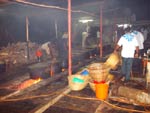 One
of the most time honored practices in Bharatiya
culture is the distribution of prasadam
after worship or a religious ritual. The word prasadam
implies a benediction and normally refers to cooked delicious
food that has been consecrated by first offering to God. Partaking
of the remnants of this offering is believed to be free of
sin, as all beings including plants have life. Partaking of
the prasadam in a reverential
manner or honoring this prasadam
as being God Himself, is also believed to confer great spiritual
benefits. One
of the most time honored practices in Bharatiya
culture is the distribution of prasadam
after worship or a religious ritual. The word prasadam
implies a benediction and normally refers to cooked delicious
food that has been consecrated by first offering to God. Partaking
of the remnants of this offering is believed to be free of
sin, as all beings including plants have life. Partaking of
the prasadam in a reverential
manner or honoring this prasadam
as being God Himself, is also believed to confer great spiritual
benefits.
While perhaps this practice is part of the
hoary traditions of Bharatiya
culture since millennia, it has its resonance in recent times
from the following verse of the Bhagavad
Gita (3.13):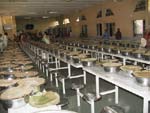
Yajna-sistasinah santo
Mucyante sarva-kilbisaih
Bhunjate te tv agham papa
Ye pacanty atma-karanat
“The devotees of the Lord are released
from all kinds of sin because they eat food, which is offered
first for sacrifice. Others, who prepare food for personal
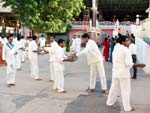 sense
enjoyment, verily eat only sin”. sense
enjoyment, verily eat only sin”.
So while food is partaken only after offering to God as a
sacrifice, emphasis is also placed not only on the correct
procurement of materials for the preparation of prasadam
(out of money earned in an honest and truthful way) but also
on the cooking process. Hence it is stressed that there should
not only be personal cleanliness but also mental and emotional
cleanliness during the cooking process. So prasadam
preparation is usually done after taking a bath, to the chanting
of Vedic hymns or the singing
of bhajans, when the mind is
totally focused on God. After the offering of the food thus
cooked in a sattwic manner to
God, it becomes prasadam.
cooking process. So prasadam
preparation is usually done after taking a bath, to the chanting
of Vedic hymns or the singing
of bhajans, when the mind is
totally focused on God. After the offering of the food thus
cooked in a sattwic manner to
God, it becomes prasadam.
Food in the Ashram is “offered”
to Swami by the recitation of the Brahmarpanam
prayer, comprising of two verses (4.24 and 15.14) of the Bhagavad
Gita, as under:
Brahmarpanam Brahma
Havir
Brahmagnou Brahmana hutam
Brahmaiva Tena Gantavyam
Brahma Karma Samadhina
Aham Vaisvanaro Bhutva
Praninam Deham asrita
Pranapana Samayuktah
Pachamy annam Chaturvidham
 “The
whole creation being a gross projection of Brahman,
the Cosmic Consciousness itself; so the food too is Brahman,
the process of offering it is Brahman,
it is being offered to the fire of Brahman.
He who thus sees Brahman in action,
alone reaches Brahman. “The
whole creation being a gross projection of Brahman,
the Cosmic Consciousness itself; so the food too is Brahman,
the process of offering it is Brahman,
it is being offered to the fire of Brahman.
He who thus sees Brahman in action,
alone reaches Brahman.
I am the fire of digestion in the stomach
of all living entities, and I join with the air of life, incoming
and outgoing, to digest the four types of food (solid, liquid,
semifluid, and fluid) which they eat”.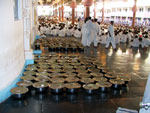
These stanzas from the Bhagavad
Gita makes us aware that food is not intended merely
to appease the endless demands of our senses of taste and
smell. It is a reminder that by thinking of God in every act
we do, even the act of taking food becomes an excellent sadhana
or spiritual exercise. If we thus remember the Divine and
then start eating food, then the food also gets purified and
becomes prasadam or a Gift of
God.
Following this ancient ritual, prasadam
is distributed on a grand scale on two major occasions in
the Ashram. (A token prasadam
of a sweet or a fruit is also distributed after Swami’s
discourse or on major festival days). The first major prasadam
distribution is after the 24 hour Akhanda
Bhajan (about 2 weeks before Swami’s birthday)
in November. The second distribution is after the all night
bhajan singing on the occasion of Maha
Sivarathri, 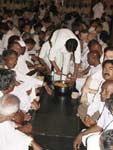 usually
in late February or early March. The fast is broken the following
morning by the serving of prasadam
to the thousands of devotees assembled in Sai Kulwant Hall. usually
in late February or early March. The fast is broken the following
morning by the serving of prasadam
to the thousands of devotees assembled in Sai Kulwant Hall.
Normally 2 dishes are offered as prasadam.
The first is Tamarind rice, a
sour dish and the other is usually Sakara
pongal (Sweetened rice) or some sweet item. As with
everything Swami does, there is an inner significance to this
also. The mixing of the sweet and the sour in the same bowl,
represents that the opposites of life, the pleasure and pain,
the hot and the cold, grief and happiness, etc. are all mixed
together. We have to partake of both with equanimity, digest
and go beyond.
Or as Swami says, “Pleasure is an interval between
two pains. Pain is an interval between two pleasures. Life
is like a piece of paper; there is no chance of having only
one side of it. Both sides will be there”.
Swami has also said, “The face is pleasure
and the feet are sorrow. When a guest comes to your home,
you can’t allow only the face inside and keep the feet
outside. If you want to welcome, you must welcome both pleasure
and pain equally. If you don’t want to welcome, you
should reject both”.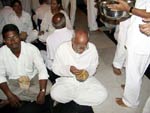
The preparation of these two (sweet and sour)
items and their timely distribution to the thousands of assembled
devotees in Sai Kulwant Hall represent a lot of planning and
labor. Procurement of items is done a few weeks prior as the
amount of items used are colossal. The cooking starts a few
hours before the distribution, and many cooks as well as Seva
Dal volunteers are involved. The cooks doing this preparation
have to do this in addition to their normal duties of cooking
for the canteens, and they do it cheerfully as yet another
way of serving the Lord, by serving His devotees.
Once the items have been prepared they are stacked for distribution
usually in the Women’s Canteen close to Sai Kulwant
Hall. Swami’s students provide the necessary labor for
distribution at the completion of the bhajan
singing. A human line is formed that snakes its way from the
entrance of the canteen to the verandah of Sai Kulwant Hall.
The serving vessels containing the food is passed from hand
to hand and stacked neatly in rows on and beside the verandah.
Adequate quantities are also made available on the women’s
side, for distribution by the lady teachers and the girl students
of the Institute.
At the conclusion of the bhajan
singing the food is blessed by Swami and the distribution
starts. The devotees arrange themselves in rows facing each
other, leaving a small space for serving in between. They
are given bowls or plates made of leaves (hence bio-degradable)
in which individual portions are served. Students from the
Institute, even young boys from the High School, volunteer
to serve their Lord by serving prasadam
to the devotees. All the devotees then honor Swami’s
prasadam by eating it quietly
and with reverence, relishing every tasty morsel while their
minds and hearts are still on the Lord, spiritually surcharged
by the many hours of bhajan singing.
Heart to Heart captures this unique event for you in pictures,
and thus brings for you a small slice of Puttaparthi Ashram
life.
|